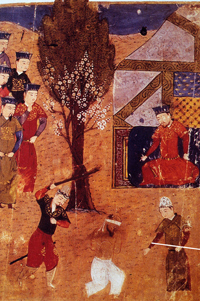Our Bonus Scene this week takes us back in time to Kazakhstan’s earliest years, featuring Genghis Khan and his descendents. And, oh yes, there is a beautiful white steppe goose too.
As happens whenever Kazakhs gathered, the animated conversation was in Kazakh. I sat quietly, content to observe them all talking at once, interrupting freely, and laughing heartily and easily with each other.
In between lengthy toasts of birthday wishes to Gulzhahan, in Kazakh, Galym regaled us — in English — with tales of the glories of Genghis Khan. He was earnest in his admiration for the man Western civilization reviles as chief barbarian.
To modern-day Kazakhs, Genghis Khan was not the schoolyard bully of Western lore, but a fearless and savvy warrior whose reach would extend to four times that of Alexander the Great. One-fourth of the world’s land and one-half the world’s people were once under his control. One factoid we could agree on: he was successful.

Upon his death in 1227, the conquered lands were divided among Genghis’ three sons, according to Mongolian custom.
China and Mongolia went to the youngest, Tole, who followed his father back home, the precedent that led to the still-honored custom of the youngest son staying home with his parents.
The middle son, Shagatay, got the land that is now Uzbekistan, Turkmenistan, the Kyrgyz Republic, and southern Kazakhstan.
Another son, Uketay, got Siberia. Genghis must not have thought much of him.
The bulk of the land that is now Kazakhstan went to Genghis’ grandsons, sons of his oldest son, Joshi, who had preceded Genghis in death. The oldest of these grandsons, Berke, divided his bounty into three groups, the precursors of the three zhuzes or hordes that continue to define Kazakh culture today.
In the early 15th century, Tamerlane (sometimes called Timur) defeated the last Mongol Khan, ending the “Golden Horde” era and leading the way for the three zhuzes of the Kazakh Khanate to form and modern Kazakh history to begin.
Or, a beautiful white steppe goose turned into a princess and gave birth to the first Kazakh (from KAZ, the Turkish word for goose and AK, their word for white).
Both stories were equally popular.
Susan Joyce
Enjoyed learning this. Thanks!
Janet Givens
Thank you Susan. I’m glad you stopped by.
Marian Beaman
Interesting history here. But the most important thing I admired about this post was the link here to your Facebook author page. First of all, I need to set up a second Facebook account. Then I need to link it with a photo as you have done on your site. Stretch and GROW!
Thanks, Janet.
Janet Givens
Hi Marian, Do you mean on the right column? I just learned TODAY about getting a custom FB address. Up until today my Author page needed this 15 digit number at the end. Ugly. It’s a constant learning curve. “The bear went over the mountain … and what do you think he saw …”
Merril Smith
Interesting to read about the different stories, Janet. Thanks.
Janet Givens
Thanks Merril. That’s what I’m hoping.
Ian Mathie
Does the white goose have a prominent position toady in Kazakh folklore? I would imagine something so symbolic being very useful, even to the extent that both histories you give above could be correct, one at the historical, factual level, the other at the symbolic, spiritual level. I like both together, they make sense..
Janet
Hi Ian
I’m partial to the white steppe goose story myself. Keeps it all so much simpler to tell. But I will say I only read of this one. Most Kazakhs, when I was there, were struggling to rediscover the facts of their history